Jan. 29th--Today I wanted to take the kids to the Nezu Art Museum. There were some exhibits that I thought would be important to see, and I had read that there was a garden in the back of the museum that was worth seeing.
Caitlin wasn't feeling like going out today, so we left the two littles with her and the rest of us set off. We took the bus this time--first time the kids had done that. We had to walk a little over 1/2 mile to the museum.
While we were walking along, Logan noticed this temple gate and asked if we could check it out. Sure, why not?To the left of the Buddhist temple gate, there was an open cemetery. We have been a little fascinated by the cemeteries here since they are so different from those in America. Because of space and religious beliefs, 99.82% of Japanese people are cremated. We have wanted to walk through a cemetery and learn more about it, but the cemeteries are always fenced and there is no access. We didn't want to be disrespectful in ANY way, but our curiosity got the best of us and so we quietly and reverently walked through this cemetery.
These statues were keeping guard at the entrance to the cemetery. At the foot of each statue, someone had placed a lemon Calpis drink. Chris couldn't believe that someone would waste good Calpis. To whomever placed it, however, it was not a waste. It was a sign of respect.
When we got home, we looked up burial practices in Japan. It was pretty interesting, but what we found to be the most intriguing (and according to the kids--gross) was that after the deceased is cremated, it is Japanese custom for the family to pick the bones out of the ashes and transfer them to an urn using chopsticks. In some instances, two family members will hold the same bone at the same time with their chopsticks or pass the bones from chopsticks to chopsticks. According to Japanese custom, this is the only time when it is proper for two people to hold the same item at the same time with chopsticks. The bones are picked up and transferred to the urn in a manner which ensures that the deceased is not placed upside down in the urn. Therefore, the bones of the feet are picked up first and the bones of the head last.
A typical Japanese grave is usually a family grave (Japanese: haka) consisting of a stone monument with a place for flowers, incense, and water in front of the monument and a chamber underneath for the ashes. The family name will be engraved on the stone. Sometimes, the names of the deceased will also be engraved on the front or side of the stone. Most often, the name is written on a sotoba, a separate wooden board on a stand behind or next to the grave. The sotoba may be erected shortly after death, and new ones may be added at certain memorial services.
We found several of these buckets in front of the family stones.
Against one of the cement fences, we noticed these statues. They were placed in order according to size....
....with this little one being the smallest at the end of the row.
Getting back to the Buddhist temple, we washed to be pure before walking around.
There was a large courtyard with several statues and small buildings around the edges. We saw two people come and worship while we were here, but we pretty much had the place to ourselves.
Christopher, Nathan's head can be seen behind the stone in the middle, Logan, and Tayla
There was a small garden area with koi fish.....
....and a turtle.
Moving on to the temple itself.
Throwing our coins in and doing the prayer ritual.
While we were standing at the coin box, a Buddhist priest came in and upon noticing us preceded to walk over to the drum and started banging on it.
To the right of the temple was this beautiful building. We had noticed that the two people who had come in to worship had gone in here, so we went over to check it out.
Notice the rain chimes on this building. They are so pretty.
We were delighted to see this very large statue inside. Don't know who she is, but it was amazing.
We were so glad that Logan had noticed this temple because it was really neat, but we had spent enough time here. Time to move on to our original plan for the day.
We finally made it to the Nezu Art Museum. We ate our packed lunch of sushi rolls and went inside.
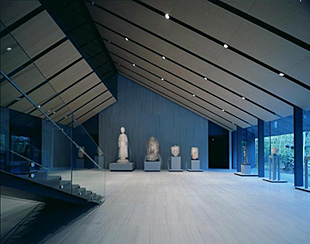
The first exhibit we saw were of various Buddha statues found in China and Japan. These dated back to 5-8th A.D. They were made of various stone, and it was interesting to notice how the details of the marble statues had faired much better over the centuries compared to the sandstone statues.
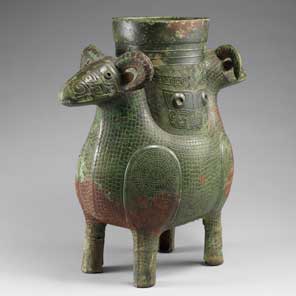
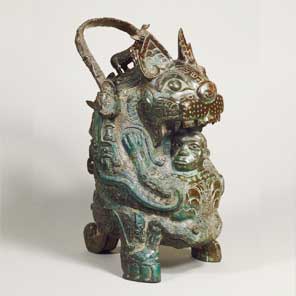
The next exhibit was a large collection of bronzes found in China. These dated to 17-11th centuries B.C. Some were bowls, others were wine vessels. The detail was amazing. It blew our mind to think about how old these were!
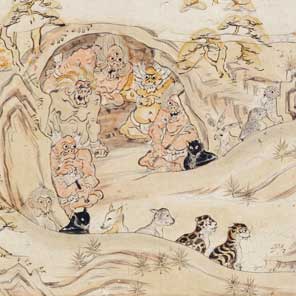
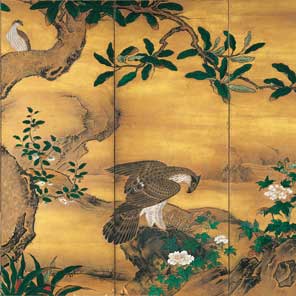
We also saw a Japanese artwork titled "Picture Scroll of the Twelve Origins of Suffering", 13th century. This scroll describes the twelve types of suffering in Buddhist teaching through the tale of brave king Setta-ō exterminating twelve demons. They looked like a fun cartoon. There were also some screens that were from the 15-16th century. We also enjoyed some paintings on silk scrolls.
 |
On the second floor of museum, we saw a 24-meter long picture scroll titled “One Hundred Camellias”. I had heard of this and it was fun to see it. The scroll contained 100 camellias arranged in common items for daily use such as a bowl, a fan, a basket, a trash tray as well as in vegetables. The scroll was planned by Tadakuni Matsudaira and was finished by his son. It took 2 generations to complete it because they asked poets, monks and scholars to write down praises for each camellia.
We then wandered out to the garden that is also a part of the museum.
Upon every turn of the numerous winding paths, there seemed to be a new garden lantern, memorial stone, Buddha or Kan'non statue.There are two ponds here, and on the museum website, they had a picture of the pond in May. The entire pond is covered with blooming irises. I know that in seeing all of the gardens we have seen, we are not viewing them at their finest. It IS still winter here, after all. But, they are still wonderful and beautiful in January to those of us who are used to nothing but snow in January. There were several old tea houses nestled in the greenery. This tea house dated back to 1739....think about that for a moment. (and by Japan's standards, this is considered fairly new) Think about what was going on in American history in 1739. Even though this garden property was severely damaged during the bombing of WWII, this tea house survived. There were many, many Buddha statues that had little plaques near them letting the viewer know how old the statue was. Most of them were from the 13th century. Waterfalls... We were excited about this guy.... ...because we found two U.S. coins among all the yen coins. He had a dime in his hand and a penny in his lap. After we had wandered on every single pathway--some of them twice--and checked out the inside of a few of the teahouses (there was storage in them), we left to walk to the metro. On the way, we noticed another temple and, because we felt like it, we checked it out. The gate was unusual in that it had this ornate artwork on the ceiling. The temple was pretty, but nothing out of the ordinary. It was also locked up and no one was in sight. We walked around for a bit and then went home. We walked a little more than 3 miles today and didn't have hardly any complaining. We got distracted a lot, but we also saw and learned a lot. Our feet hurt when we got home, but it was a good day.
Here's what the kids thought of the day:
Tayla: The temple that we went to on the way to the museum was really cool and the cemetery was cool to see, too. I really liked seeing the turtle. I really liked the bronzes and Buddha statues at the museum. The garden was probably my favorite part because it was really pretty and peaceful.
Christopher: Cool. The cookies that we had for lunch were good.
Logan: I enjoyed seeing all of the scrolls and old wine vessels and bowls in the museum. I also enjoyed seeing all of the shrines and temples that we noticed. The garden behind the museum with all of the statues was pretty neat.
Nathan: I liked the fish and the turtle. I liked the things we saw in the building. We walked a long way.
|







































No comments:
Post a Comment